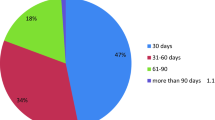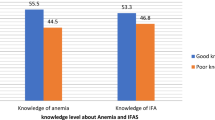Abstract
One in five maternal deaths are directly attributable to anaemia in the world. The World Health Organization recommends iron supplementation from the second trimester of pregnancy to 45 days after delivery. The aim of this study was to determine the compliance rate of iron-folate consumption and the factors associated with iron-folate consumption among post-natal mothers in Nepal. This study utilised the data of Nepal Demographic and Health Survey (NDHS) 2011. The NDHS 2011 is a cross sectional and nationally representative survey. Of the 4,148 respondents, only 20.7 % consumed iron throughout the post-natal period for 45 days. Mothers who had higher and secondary education [adjusted Odd ratio (aOR) 3.101; 95 % CI (2.268–4.240)]; had attended four or more antenatal care visits [aOR 9.406; 95 % CI (5.552–15.938)]; lived in Far-western development region [aOR 1.822; 95 % CI (1.387–2.395)]; delivered in health facility [aOR 1.335; 95 % CI (1.057–1.687)]; and attended postnatal care [aOR 2.348; 95 % CI (1.859–2.965)] were more likely to take iron for 45 days of postpartum. Intervention to increase the compliance with the postpartum iron-folate supplementation are required to avoid adverse pregnancy outcomes associated with poor iron status with especial focus on the mothers who delivered at homes and did not attend post-natal check up.

Similar content being viewed by others
References
Balarajan, Y., Ramakrishnan, U., Özaltin, E., Shankar, A., & Subramanian, S. (2011). Anaemia in low-income and middle-income countries. Lancet. doi: 10.1016/S0140-6736(10)62304-5.
Bennett, L., Dahal, D., & Govindasamy, P. (2008). Caste, ethnic and regional identity in Nepal: Further analysis of the 2006 Nepal Demographic and Health Survey. Calverton: Macro International Inc.
Casey, G., Phuc, T., MacGregor, L., Montresor, A., Mihrshahi, S., Thach, T., & Biggs, B. (2009). A free weekly iron-folic acid supplementation and regular deworming program is associated with improved hemoglobinic and iron status indicators in Vietnamese women. BMC Public Health, 9(26). doi: 10.1186/1471-2458-9-261.
Chakraborty, N., Ataharul Islam, N., Chowdhury, R., & Bari, W. (2002). Utilisation of postnatal care in Bangladesh: Evidence from a longitudinal study. Health and Social Care in the Community, 10(6), 492–502.
Child Health Division, and Ministry of Health and Population. (2004). National Nutrition Policy and Strategy. Kathmandu: Child Health Division, and Ministry of Health and Population.
Christian, P., Stewart, C., LeClerq, S., Wu, L., Katz, J., West, K., & Khatry, S. (2009). Antenatal and postnatal iron supplementation and childhood mortality in rural Nepal: A prospective follow-up in a randomized controlled community trial. American Journal of Epidemiology, 170(90). doi: 10.1093/aje/kwp253.
Dhakal, S., Chapman, G. N., Simkhada, P. P., van Teijlingen, E. R., Stephens, J., & Raja, A. E. (2007). Utilisation of postnatal care among rural women in Nepal. BMC Pregnancy Childbirth, 7, 19. doi:10.1186/1471-2393-7-19.
Doku, D., Subas Neupane, S., & Doku, P. (2012). Factors associated with reproductive health care utilization among Ghanaian women. BMC International Health and Human Rights, 12(29). doi: 10.1186/1472-698X-12-29.
Horton, S., & Ross, J. (2003). Food Policy. The economics of iron deficiency, 28(1), 51–75.
Kerber, K., Graft-Johnson, J., Bhutta, Z., Okong, P., Starrs, A., & Lawn, J. (2007). Continuum of care for maternal, newborn, and child health: from slogan to service delivery. Lancet, 370, 1358–1369.
Khanal, V., Adhikari, A., & Karkee, R. (2013). Social determinants of poor knowledge on HIV among Nepalese males: Findings from National Survey 2011. Journal of Community Health, In print. doi: 10.1007/s10900-013-9727-4.
Khanal, V., & Sauer, K. (2013). Determinants of the introduction of prelatical feeds in rural Nepal: A cross-sectional community-based study. Breastfeed Med, 8(3), 336–339.
Masvie, H. (2006). The role of Tamang mothers-in-law in promoting breast feeding in Makwanpur District, Nepal. Midwifery, 22(1), 23–31.
Ministry of Health and Population. (2011). Annual report 2010/2011.
Ministry of Health and Population (MOHP) [Nepal], New ERA, & ICF International Inc. (2012). Nepal Demographic and Health Survey 2011 Kathmandu, Nepal: Ministry of Health and Population, New ERA, and ICF International. Maryland: Calverton.
Neupane, S., & Teye Doku, D. (2011). Determinants of time of start of prenatal care and number of prenatal care visits during pregnancy among Nepalese women. Journal of Community Health. doi: 10.1007/s10900-011-9521-0.
Rutstein, O., & Rojas, G. (2012). Guide to DHS statistics. Maryland: Measure DHS.
Simkhada, B., Porter, M., & Teijlingen, E. (2010). The role of mothers-in-law in antenatal care decision-making in Nepal: A qualitative study. BMC Pregnancy and Childbirth, 10(34). doi: doi:10.1186/1471-2393-10-34.
WHO. (2001). Iron deficiency anemia—assessment, prevention and control. A guide for programme managers WHO/NHD/01.3. Genva.
WHO. (2006). Iron and folate supplementation integrated management of pregnancy and childbirth. Geneva: WHO.
Yakoob, M., & Bhutta, Z. (2011). Effect of routine iron supplementation with or without folic acid on anemia during pregnancy. BMC Public Health, 11(Suppl 3). doi: 10.1186/1471-2458-11-S3-S21.
Author information
Authors and Affiliations
Corresponding author
Rights and permissions
About this article
Cite this article
Khanal, V., Adhikari, M. & Karkee, R. Low Compliance with Iron-Folate Supplementation Among Postpartum Mothers of Nepal: An Analysis of Nepal Demographic and Health Survey 2011. J Community Health 39, 606–613 (2014). https://doi.org/10.1007/s10900-013-9806-6
Published:
Issue Date:
DOI: https://doi.org/10.1007/s10900-013-9806-6




